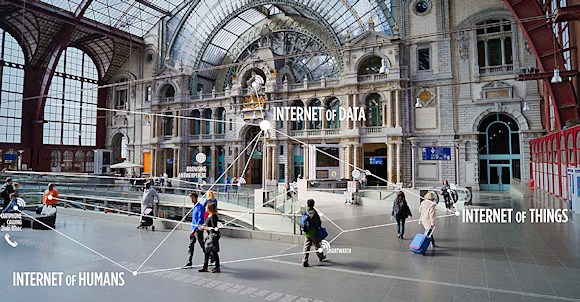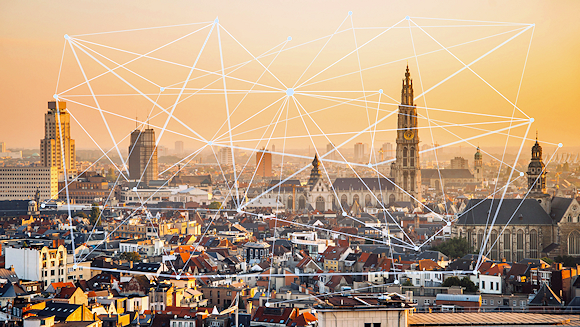
The essence of a smart city is not that it is crammed full of new technology. First and foremost it is a city in which the quality of living is lifted to a new level, fulfilling the practical needs and expectations of the people who live there. To see how this could be realized, the city council of Antwerp and a number of committed companies have set up a smart city project, making Antwerp one of the world's largest living labs of smart city technology. In 2016, the foundations were laid of what may become a benchmark for urban environments worldwide.
Evangelize And Build Gateways
The goal of the 'City of Things' project is to examine how a smart city may be developed as part of a realistic framework, in a large city and working in close collaboration with the residents and the city council. A first requirement for the success of such a complex urban project is to make sure all the stakeholders are on the same page. That requires a lot of evangelization, making sure that everyone is given the same level of expertise.
Part of that process involved publishing a reference book, which is now already in its fourth edition. The first aim was to enthuse policymakers, in Antwerp but also in other cities, while at the same time ensuring that every city didn't start crafting its own solution. Because when that happens, everything gets fragmented, with systems that don't talk to each other and cities that spend years tied to certain solutions and suppliers.
Once the project is up and running, 100 gateways will have been put in place across Antwerp. These will literally be the digital entry gates to the city and its inhabitants, complete with supporting technology. Gateways through which tens of thousands of wireless sensors, worn by the locals or attached to vehicles, the traffic infrastructure or buildings, can send their data to a whole range of applications.

The City of Antwerp
At the moment, there are already 20 of these gateways in operation. The rest will be installed gradually. Everyone will be able to use them to develop or evaluate a specific smart application. The technology is heterogeneous, not based on a single solution or protocol, but on a series of standards that are suited to these applications, such as Zigbee, WiFi, Cellulair, LoRa, SigFox and others.
Next page
Senses For The City
Imec specializes in making environments smart. There are, for instance, currently two vans of the Belgian Post Office going about their business every day around Antwerp equipped with imec's wireless multi-parameter sensors. These can now take readings for around 20 parameters, such as CO2 and NO2. And soon they will be able to measure fine pollution particles.
The aim is to arrive at more refined measurements, with hundreds of sensors installed all over the city, aboard a larger number of vehicles driving around. These readings can be linked to weather forecasts and knowledge of the local terrain and mobility. Eventually, they should make for a very detailed map of the city indicating e.g. air quality down to the level of street corners.
Other technologies that fit in with this smart city scenario are a new ion sensor and a 60 GHz wireless backhaul. The first ion sensors have already been installed at a water pollution sampling station in the river Scheldt. The 60 GHz solution for backhaul networks will be developed to expand the available communication bandwidth quickly and seamlessly when major events are being staged or emergencies occur.
The sensors and gateways are only a first layer, the senses of the smart city. Behind it all is an infrastructure for processing and analyzing big data in real-time. Like the gateways, this infrastructure is also technology-neutral and offers everyone who wants to use it a set of tools for converting data into useful knowledge. With the sensor data relating to air quality, one of the scenarios that is considered for 2017 is an app for cyclists and pedestrians indicating the healthiest and safest route to a particular location.
Changing Behavior
All of this infrastructure will only form the foundation of the new digital city. To make it really smarter and more pleasant, the inhabitants will have to be involved. That is why the project will be recruiting a large number of volunteers from 2017 on. These will be put to good use, taking part in test panels that evaluate and gradually improve the new applications at every stage of their development from initial idea to prototype. That way the city will become a genuine living lab. As it is developed and staged, people are questioned about how they use a particular application, what they value or dislike, and whether they would be prepared to pay for the application and how much.
But in this project, the researchers also want to test whether – and how – applications can influence people's behavior. How can a smart app encourage people to behave more sustainably or more healthily? And how can it do that without forcing them or taking some of their comfort away?
This type of behavioral change is the basis for many new business or governance models: the so-called outcome-based economy. It will also be one of the big challenges facing smart environments in the years ahead.

Flanders set to be the smart region
In the meantime, the government has already taken up some of the ideas and concepts of the project's experts. For 2017, imec is commissioned to work on the standards for open data as well as on the first pilot projects to set up Flanders as a smart region. This does not mean that all cities are required to implement the same policy: everyone is given a number of tools that support their own policies and areas of emphasis in a smarter way.
Next page
Living lab for the world
There's an international component as well. As part of the European 'Horizon 2020' project, Antwerp will become one of the European reference zones, along with six other European cities. The aim is to establish large-scale pilot projects featuring experiments with new IoT services, based on the real needs of citizens. The Antwerp reference zone will focus mainly on mobility and logistics.
Originally, the City of Things project was set up by iMinds, a research center that had a great deal of expertise in digital technologies, as well as in setting up large-scale living labs. But since October, iMinds has been merged with imec.
Next to harmonizing the organization and technology on a local level, we can now look at the challenges facing large conurbations worldwide, working to attract an international following. All around the world there are many smart city initiatives going on and the challenge there is to differentiate the City of Things project. Yet in discussions with partners, often leading companies, people have said that they are very interested in this particular approach, mainly because of its scope and breath, working on open technological innovation in a living lab, while at the same time also on applications, scenarios, business models, social organization and awareness.
About the Authors
Kathleen Philips is program director at imec/Holst Centre for infrastructure and person-centric focused Perceptive Systems. Kathleen joined imec in 2007 and has held positions as principal scientist, program manager for ULP Wireless and program director for Perceptive Systems. Before that, she was a research scientist at Philips Research for over 12 years. She holds a PhD in electrical engineering, has authored and co-authored over 60 papers, and holds various patents.
Pieter Ballon is a director of imec/VUB-SMIT and professor at VUB Brussels (Belgium). Pieter specializes in living lab research, business modelling, open innovation and the mobile telecommunications industry. He has been involved in numerous local and international R&D projects in this field, and has published widely on these topics. Currently, he is international Secretary of ENoLL, the European Network of Living Labs. Pieter holds a PhD in Communication Sciences and a MA in Modern History.
Related Stories
The Smart City Project in Santander
Managing the Flow: Smart Sensors for Smart Cities
Digi International Enabling Smart City Solutions Worldwide
Deloitte and AT&T Form Alliance to Build Smart Cities
Schréder signs Smart City partnership with Panasonic
Telematics Wireless to Implement Smart City Technology in the City of Montreal, Canada
SCDA Framework Accelerates Large IoT Projects In Smart Cities